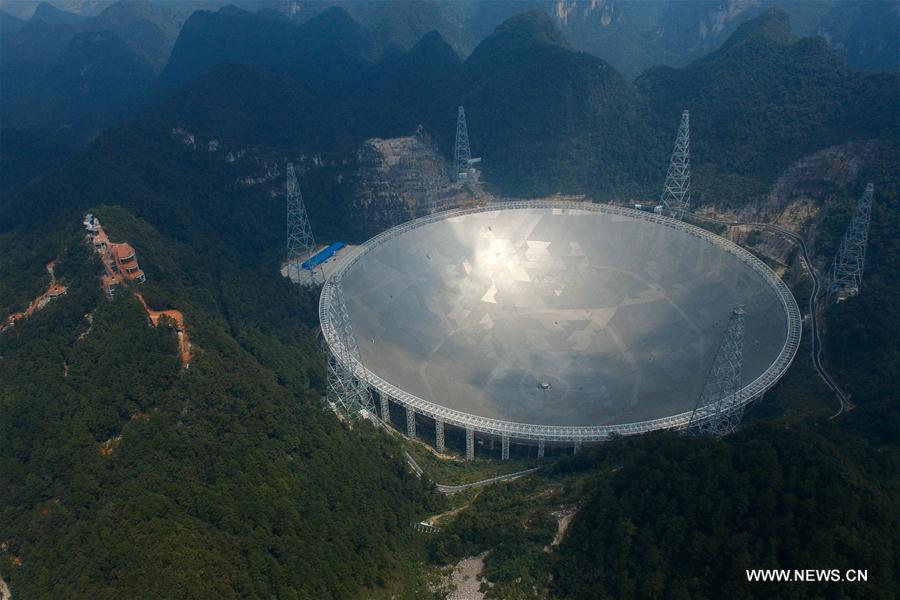
Photo taken on Sept. 24, 2016 shows the 500-meter Aperture Spherical Telescope (FAST) in Pingtang County, southwest China's Guizhou Province. The FAST, world's largest radio telescope, measuring 500 meters in diameter, was completed and put into use on Sunday. (Xinhua/Ou Dongqu)
GUIYANG, Sept. 25 (Xinhua) -- The world's largest radio telescope was put into use on Sunday in a mountainous region of southwest China's Guizhou Province.
Shortly after noon, in a karst valley in Pingtang County, hundreds of astronomers and astronomy enthusiasts witnessed the official launch of the Five-hundred-meter Aperture Spherical Telescope's (FAST) mission to explore space and hunt for extraterrestrial life.
Chinese President Xi Jinping sent a congratulatory letter to scientists, engineers and builders on the launch.
Work on the nearly 1.2-billion-yuan (180 million U.S. dollars) project started in 2011, 17 years after it was proposed by Chinese astronomers.
The installation of the telescope's main structure -- a 4,450-panel reflector as large as 30 football pitches -- was finished in early July.
"(The telescope) will certainly generate enthusiasm, bring people into science, and make China important in the world of science," Joseph Taylor, a Nobel Prize-winning astronomer at Princeton University, told Xinhua.
The astronomer was awarded the Nobel Prize in physics in 1993 for discovering indirect proof of gravitational waves with the assistance of Puerto Rico's Arecibo Observatory, home to a radio telescope that is 350 meters in diameter.
Taylor expects FAST to be a "productive" project, even if he is unsure whether any of its discoveries will lead to a Nobel Prize.
In fact, FAST has already had a good start. In a recent trial observation, it received a set of high-quality electromagnetic waves sent from a pulsar about 1,351 light-years away, said Qian Lei, an associate researcher with the National Astronomical Observation (NAO) under the Chinese Academy of Sciences, which built the project.
FAST's tasks include observation of pulsars as well as exploration of interstellar molecules and interstellar communication signals.
The telescope is expected to discover twice the number of pulsars as are currently known and its is highly likely to make breakthroughs in the study of gravitational waves and general relativity theory, said Sun Caihong, its deputy chief technologist.
In the first two or three years after its completion, the telescope will undergo further adjustment, and during that period Chinese scientists will use it for early stage research. After that, it will be open to scientists worldwide.
The telescope's chief technologist, Wang Qiming, said FAST, designed and built by Chinese scientists, will remain the global leader for the next 10 to 20 years.
Yan Jun, head of the NAO, said China will roll out more "world-class" telescope projects in five to 10 years.
TOWN REINVENTED
FAST is believed to be the world's most sensitive radio telescope. Engineers have said it is so sensitive it could capture the signal of a cell phone being used on the moon.
To ensure the telescope's performance, more than 8,000 locals are being resettled from their homes to make way for the project, which requires radio silence within a 5-kilometer radius. Visitors to the zone must turn off their mobile phones.
A relocation budget of about 1.8 billion yuan has come from the poverty relief fund and bank loans. Over 600 apartments have been built in two new settlements, about 10 kilometers from their original homes.
The villagers will be compensated in cash or with new housing. Those who lost their land will also be compensated. They will be offered jobs in tourism and support services for the FAST project.
The local government hopes to develop tourism by cashing in on the buzz surrounding the telescope.
Starting from Monday, the "scenic zone" around FAST will be open to tourists on a trial basis, according to the tourism bureau of Pingtang County.
During the trial opening, a daily ceiling of 2,000 tourists, at a ticket price of 368 yuan each, will be allowed to visit an observation deck built at the top of a mountain nearby to observe FAST.
The zone will also feature a 300-hectare telescope-themed "cultural park." The park, located more than 5 kilometers from FAST in Pingtang's Kedu Township, includes a 5,000-square-meter planetarium to provide an interactive experience.
"I believe the planetarium will be a hot destination for tourism and education for the popularization of science," said Zhang Liyun, an associate professor of astronomy at Guizhou University.
To prevent interference with FAST's operations, visitors are required to deposit all their electric gadgets, such as mobile phones, digital cameras and smart wristbands, before entering the observation deck.
"There are successful examples of coexistence between a radio telescope and 'astronomy towns' outside China," said Zhang Shuxin, deputy manager of the FAST project. "The key is a strict ban on electronic devices in the zone."











